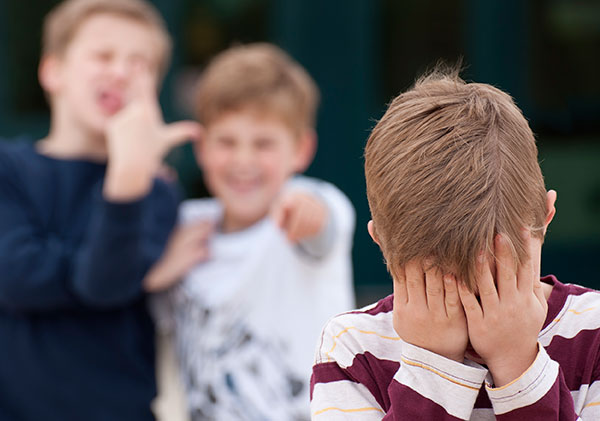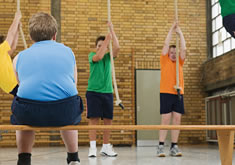Efectos del bullying

1 Olweus D. Bullying at school: What we know and what we can do. Wiley-Blackwell, 1993.
2 Bjorkqvist K, Lagerspetz KM, Kaukiainen A. Do girls manipulate and boys fight? Developmental trends in regard to direct and indirect aggression. Aggress Behav 1992; 18:117–27.
3 Wolke D, Woods S, Bloomfield L, et al. The association between direct and relational bullying and behaviour problems among primary school children. J Child Psychol Psychiatry 2000; 41:989–1002.
4 Crick NR, Grotpeter JK. Children’s treatment by peers: Victims of relational and overt aggression. Dev Psychopathol 1996; 8:367–80.
5 Haynie DL, Nansel T, Eitel P, et al. Bullies, victims, and bully/victims: Distinct groups of at-risk youth. J Early Adolesc 2001; 21:29–49.
6 Boulton MJ, Smith PK. Bully/victim problems in middle-school children: Stability, self-perceived competence, peer perceptions and peer acceptance. Br J Dev Psychol 1994; 12:315–29.
7 World Health Organization. Risk behaviours: being bullied and bullying others. In: Currie C, Zanotti C, Morgan A, et al, eds. Social determinants of health and well-being among young people. Health Behaviour in School-aged Children (HBSC) study: International report from the 2009/2010 survey. Copenhagen: WHO Regional Office for Europe, 2012:191–200.
8 Wolke D, Lereya ST, Fisher HL, et al. Bullying in elementary school and psychotic experiences at 18 years: a longitudinal, population-based cohort study. Psychol Med 2014; 44:2199–211.
9 Copeland WE, Wolke D, Angold A, et al. Adult psychiatric outcomes of bullying and being bullied by peers in childhood and adolescence. JAMA Psychiatry 2013; 70:419–26.
10 Olweus D. Cyber bullying: An overrated phenomenon? Eur J Dev Psychol 2012; 9:520–38.
11 Radford L, Corral S, Bradley C, et al. The prevalence and impact of child maltreatment and other types of victimization in the UK: Findings from a population survey of caregivers, children and young people and young adults. Child Abuse Negl 2013; 37:801–13.
12 Tippett N, Wolke D, Platt L. Ethnicity and bullying involvement in a national UK youth sample. J Adolesc 2013; 36:639–49.
13 Wolke D, Woods S, Stanford K, et al. Bullying and victimization of primary school children in England and Germany: Prevalence and school factors. Br J Psychol 2001; 92:673–96.
14 Olthof T, Goossens FA, Vermande MM, et al. Bullying as strategic behavior: Relations with desired and acquired dominance in the peer group. J Sch Psychol 2011; 49:339–59.
15 Volk AA, Camilleri JA, Dane AV, et al. Is adolescent bullying an evolutionary adaptation? Aggress Behav 2012; 38:222–38.
16 Hawley PH, Little TD, Card NA. The myth of the alpha male: a new look at dominance-related beliefs and behaviors among adolescent males and females. Int J Behav Dev 2008; 32:76–88.
17 Woods S, Wolke D, Novicki S, et al. Emotion recognition abilities and empathy of victims of bullying. Child Abuse Negl 2009; 33:307–11.
18 Tippett N, Wolke D. Socioeconomic status and bullying: a meta-analysis. Am J Public Health 2014; 104:e48–e59.
19 Camodeca M, Goossens FA, Schuengel C, et al. Links between social informative processing in middle childhood and involvement in bullying. Aggress Behav 2003; 29:116–27.
20 Wolke D, Skew A. Family factors, bullying victimisation and wellbeing in adolescents. Longit Life Course Stud 2012; 3:101–19.
21 Garandeau C, Lee I, Salmivalli C. Inequality matters: classroom status hierarchy and adolescents’ bullying. J Youth Adolesc 2014; 43:1123–33.
22 Wolke D, Skew AJ. Bullying among siblings. Int J Adolesc Med Health 2012; 24:17–25.
23 Elgar FJ, Craig W, Boyce W, et al. Income inequality and school bullying: multilevel study of adolescents in 37 countries. J Adolesc Health 2009; 45:351–9.
24 Ahn HJ, Garandeau CF, Rodkin PC. Effects of classroom embeddedness and density on the social status of aggressive and victimized children. J Early Adolesc 2010; 30:76–101.
25 Schafer M, Korn S, Brodbeck FC, et al. Bullying roles in changing contexts: the stability of victim and bully roles from primary to secondary school. Int J Behav Dev 2005; 29:323–35.
26 Barker ED, Arseneault L, Brendgen M, et al. Joint development of bullying and victimization in adolescence: relations to delinquency and self-harm. J Am Acad Child Adolesc Psychiatry 2008; 47:1030–8.
27 Wichstrøm L, Belsky J, Berg-Nielsen TS. Preschool predictors of childhood anxiety disorders: a prospective community study. J Child Psychol Psychiatry 2013; 54:1327–36.
28 Siegel R, La Greca A, Harrison H. Peer victimization and social anxiety in adolescents: prospective and reciprocal relationships. J Youth Adolesc 2009; 38:1096–109.
29 Storch EA, Masia-Warner C, Crisp H, et al. Peer victimization and social anxiety in adolescence: a prospective study. Aggress Behav 2005; 31:437–52.
30 Wolke D, Schreier A, Zanarini MC, et al. Bullied by peers in childhood and borderline personality symptoms at 11 years of age: a prospective study. J Child Psychol Psychiatry 2012; 53:846–55.
31 Zwierzynska K, Wolke D, Lereya TS. Peer victimization in childhood and internalizing problems in adolescence: a prospective longitudinal study. J Abnorm Child Psychol 2013; 41:309–23.
32 Arseneault L, Milne BJ, Taylor A, et al. Being bullied as an environmentally mediated contributing factor to children’s internalizing problems: a study of twins discordant for victimization. Arch Pediatr Adolesc Med 2008; 162:145–50.
33 Kaltiala-Heino R, Fröjd S, Marttunen M. Involvement in bullying and depression in a 2-year follow-up in middle adolescence. Eur Child Adolesc Psychiatry 2010; 19:45–55.
34 Kumpulainen K, Rasanen E. Children involved in bullying at elementary school age: their psychiatric symptoms and deviance in adolescence. An epidemiological sample. Child Abuse Negl 2000; 24:1567–77.
35 Sweeting H, Young R, West P, et al. Peer victimization and depression in early–mid adolescence: a longitudinal study. Br J Educ Psychol 2006; 76:577–94.
36 Reijntjes A, Kamphuis JH, Prinzie P, et al. Peer victimization and internalizing problems in children: a meta-analysis of longitudinal studies. Child Abuse Negl 2010; 34:244–52.
37 Schreier A, Wolke D, Thomas K, et al. Prospective study of peer victimization in childhood and psychotic symptoms in a nonclinical population at age 12 years. Arch Gen Psychiatry 2009; 66:527–36.
38 van Dam DS, van der Ven E, Velthorst E, et al. Childhood bullying and the association with psychosis in non-clinical and clinical samples: a review and meta-analysis. Psychol Med 2012; 42:2463–74.
39 Gini G, Pozzoli T. Association between bullying and psychosomatic problems: a meta-analysis. Pediatrics 2009; 123:1059–65.
40 Wolke D, Lereya ST. Bullying and parasomnias: a longitudinal cohort study. Pediatrics 2014; 134:e1040–8.
41 Wolke D, Woods S, Bloomfield L, et al. Bullying involvement in primary school and common health problems. Arch Dis Child 2001; 85:197–201.
42 Gini G, Pozzoli T. Bullied children and psychosomatic problems: a meta-analysis. Pediatrics 2013; 132:720–9.
43 Lereya ST, Winsper C, Heron J, et al. Being bullied during childhood and the prospective pathways to self-harm in late adolescence. J Am Acad Child Adolesc Psychiatry 2013; 52:608–18.e2.
44 Fisher HL, Moffitt TE, Houts RM, et al. Bullying victimisation and risk of self harm in early adolescence: longitudinal cohort study. BMJ 2012; 344:e2683.
45 Winsper C, Lereya T, Zanarini M, et al. Involvement in bullying and suicide-related behavior at 11 years: a prospective birth cohort study. J Am Acad Child Adolesc Psychiatry 2012; 51:271–82.e3.
46 Bannink R, Broeren S, van de Looij-Jansen PM, et al. Cyber and traditional bullying victimization as a risk factor for mental health problems and suicidal ideation in adolescents. PLoS One 2014; 9:e94026.
47 Nakamoto J, Schwartz D. Is peer victimization associated with academic achievement? A meta-analytic review. Soc Dev 2010; 19:221–42.
48 Schwartz D, Gorman AH, Nakamoto J, et al. Victimization in the peer group and children’s academic functioning. J Educ Psychol 2005; 79:425–35.
49 Vaillancourt T, Brittain H, McDougall P, et al. Longitudinal links between childhood peer victimization, internalizing and externalizing problems, and academic functioning: developmental cascades. J Abnorm Child Psychol 2013; 41:1203–15.
50 Foshee VA, McNaughton Reyes HL, Vivolo-Kantor AM, et al. Bullying as a longitudinal predictor of adolescent dating violence. J Adolesc Health 55:439–44.
51 Vaillancourt T, McDougall P. The link between childhood exposure to violence and academic achievement: complex pathways. J Abnorm Child Psychol 2013; 41:1177–8.
52 Arseneault L, Bowes L, Shakoor S. Bullying victimization in youths and mental health problems: “Much ado about nothing”? Psychol Med 2010; 40:717–29.
53 Juvonen J, Graham S, Schuster MA. Bullying among young adolescents: the strong, the weak, and the troubled. Pediatrics 2003; 112:1231–7.
54 Ttofi MM, Farrington DP, Lösel F, et al. The predictive efficiency of school bullying versus later offending: A systematic/meta-analytic review of longitudinal studies. Crim Behav Ment Health 2011; 21:80–9.
55 Stapinski LA, Bowes L, Wolke D, et al. Peer victimization during adolescence and risk for anxiety disorders in adulthood: a prospective cohort study. Depress Anxiety 2014; 31:574–82.
56 Takizawa R, Maughan B, Arseneault L. Adult health outcomes of childhood bullying victimization: evidence from a five-decade longitudinal British birth cohort. Am J Psychiatry 2014; 171:777–84.
57 Wolke D, Copeland WE, Angold A, et al. Impact of bullying in childhood on adult health, wealth, crime, and social outcomes. Psychol Sci 2013; 24:1958–70.
58 Sourander A, Brunstein Klomek A, Kumpulainen K, et al. Bullying at age eight and criminality in adulthood: findings from the Finnish Nationwide 1981 Birth Cohort Study. Soc Psychiatry Psychiatr Epidemiol 2011; 46:1211–19.
59 Bender D, Losel F. Bullying at school as a predictor of delinquency, violence and other anti-social behaviour in adulthood. Crim Behav Ment Health 2011; 21:99–106.
60 Renda J, Vassallo S, Edwards B. Bullying in early adolescence and its association with anti-social behaviour, criminality and violence 6 and 10 years later. Crim Behav Ment Health 2011; 21:117–27.
61 Sourander A, Jensen P, Ronning JA, et al. Childhood bullies and victims and their risk of criminality in late adolescence: the Finnish From a Boy to a Man Study. Arch Pediatr Adolesc Med 2007; 161:546–52.
62 Sourander A, Jensen P, Ronning JA, et al. What is the early adulthood outcome of boys who bully or are bullied in childhood? The Finnish “From a Boy to a Man” study. Pediatrics 2007; 120:397–404.
63 Brunstein-Klomek A, Sourander A, Kumpulainen K, et al. Childhood bullying as a risk for later depression and suicidal ideation among Finnish males. J Affect Disord 2008; 109:47–55.
64 Copeland WE, Wolke D, Lereya ST, et al. Childhood bullying involvement predicts low-grade systemic inflammation into adulthood. Proc Natl Acad Sci USA 2014; 111:7570–5.
65 Sigurdson JF, Wallander J, Sund AM. Is involvement in school bullying associated with general health and psychosocial adjustment outcomes in adulthood? Child Abuse Negl 2014; 38:1607–17.
66 Niemelä S, Brunstein-Klomek A, Sillanmäki L, et al. Childhood bullying behaviors at age eight and substance use at age 18 among males. A nationwide prospective study. Addict Behav 2011; 36:256–60.
67 Brunstein Klomek A, Sourander A, Gould MS. The association of suicide and bullying in childhood to young adulthood: a review of cross-sectional and longitudinal research findings. Can J Psychiatry 2010; 55:282–8.
68 Brunstein-Klomek A, Sourander A, Niemelä S, et al. Childhood bullying behaviors as a risk for suicide attempts and completed suicides: A population-based birth cohort study. J Am Acad Child Adolesc Psychiatry 2009; 48:254–61.
69 Brown S, Taylor K. Bullying, education and earnings: evidence from the National Child Development Study. Econ Educ Rev 2008; 27:387–401.
70 Lehti V, Klomek AB, Tamminen T, et al. Childhood bullying and becoming a young father in a national cohort of Finnish boys. Scand J Psychol 2012; 53:461–6.
71 Lehti V, Sourander A, Klomek A, et al. Childhood bullying as a predictor for becoming a teenage mother in Finland. Eur Child Adolesc Psychiatry 2011; 20:49–55.
72 Bogart LM, Elliott MN, Klein DJ, et al. Peer victimization in fifth grade and health in tenth grade. Pediatrics 2014; 133:440–7.
73 Sutton J, Smith PK, Swettenham J. Social cognition and bullying: Social inadequacy or skilled manipulation? Br J Dev Psychol 1999; 17:435–50.
74 Ouellet-Morin I, Danese A, Bowes L, et al. A discordant monozygotic twin design shows blunted cortisol reactivity among bullied children. J Am Acad Child Adolesc Psychiatry 2011; 50:574–82.e3.
75 Sugden K, Arseneault L, Harrington H, et al. Serotonin transporter gene moderates the development of emotional problems among children following bullying victimization. J Am Acad Child Adolesc Psychiatry 2010; 49:830–40.
76 Shalev I, Moffitt TE, Sugden K, et al. Exposure to violence during childhood is associated with telomere erosion from 5 to 10 years of age: a longitudinal study. Mol Psychiatry 2012; 18:576–81.
77 Harkness KL, Stewart JG, Wynne-Edwards KE. Cortisol reactivity to social stress in adolescents: role of depression severity and child maltreatment. Psychoneuroendocrinology 2011; 36:173–81.
78 Segerstrom SC, Miller GE. Psychological stress and the human immune system: a meta-analytic study of 30 years of inquiry. Psychol Bull 2004; 30: 601–30.
79 Kaptoge S, Di Angelantonio E, Lowe G, et al; Emerging Risk Factors Collaboration. C-reactive protein concentration and risk of coronary heart disease, stroke, and mortality: an individual participant meta-analysis. Lancet 2010;375: 132–40.
80 Jousilahti P, Salomaa V, Rasi V, et al. Association of markers of systemic inflammation, C reactive protein, serum amyloid A, and fibrinogen, with socioeconomic status. J Epidemiol Community Health 2003; 57:730–3.
81 Sapolsky RM. The influence of social hierarchy on primate health. Science 2005; 308:648–52.
82 Mezulis AH, Abramson LY, Hyde JS, et al. Is There a universal positivity bias in attributions? A meta-analytic review of individual, developmental, and cultural differences in the self-serving attributional bias. Psychol Bull 2004; 130:711–47.
83 Teicher MH, Samson JA, Sheu YS, et al. Hurtful words: association of exposure to peer verbal abuse with elevated psychiatric symptom scores and corpus callosum abnormalities. Am J Psychiatry 2010; 167:1464–71.
84 Brown V, Clery E, Ferguson C. Estimating the prevalence of young people absent from school due to bullying. Nat Centre Soc Res 2011; 1:1–61.
85 Masiello M, Schroeder D, Barto S, et al. The cost benefit: a first-time analysis of savings. Highmark Foundation, 2012:1–13.
86 Brown V, Clery E, Ferguson C. Estimating the prevalence of young people absent from school due to bullying. National Centre for Social Research.
http:// redballoonlearnercouk/includes/files/resources/261298927_red-balloon-natcenresearch- reportpdfBrown, 2011:1–61.
87 Chamberlain T, George N, Golden S, et al. Tellus4 national report: National Foundation for Educational Research. The Department for Children, Schools and
Families, 2010.
88 Scrabstein JC, Merrick J. Bullying is everywhere: an expanding scope of public health concerns. Int J Adolesc Med Health 2012; 24:1.
89 Dale J, Russell R, Wolke D. Intervening in primary care against childhood bullying: an increasingly pressing public health need. J R Soc Med 2014; 107:219–23.
Comentarios
Para ver los comentarios de sus colegas o para expresar su opinión debe ingresar con su cuenta de IntraMed.









